#and also terrain tools were a little easier to use in my opinion
Text
Wooo
Already got the outside of my apartment building done so im ready for tomorrow
Since we already know we're gonna have cheats to expand the number of units on one lot it has 8 units instead of 6
I'm basing it off luxury townhouses you'd find in New York
4 of them are gonna be occupied by sim families i make and are gonna be super personalized for those sims while the other 4 are gonna be more basic and just have random families
Right now I have it on the 64x64 lot in del sol Valley but I might move it somewhere else. Havent decided yet. Initially when I thought "luxury townhouses" I picture something in LA but as I've been building, the style fits the new England area better sooooo....not sure which sim world with a 64x64 would work for that. I think the park in San myshuno is 64x64 so I might put it there but the style could maybe fit in windenburg....but the area that the windenburg 64x64 lot is in doesn't really work for apartments.
#i am excite#havent had the drive to build in awhile#or play sims at all for that matter#but my favorite kind of build is back#and i feel like ive improved my apartment building skills#like its still kind of a big box like in sims 2#but its not an ugly box#thats also just partly cuz build mode in sims 4 is so much better#i loved sims 2. but build mode in that game sucked lol#the only thing it had over sims 4 was you could build apartments if you had the apartment life pack#and also terrain tools were a little easier to use in my opinion#but ive gotten the hang of sims 4 terrain tools#and now we're getting an apartment pack#actually thought of something else i preferred in sims 2#being able to choose the bedding swatch and the bed frame swatch separately#or the upholstery swatch and the wood/metal swatches on the couches or chairs#that was nice
7 notes
·
View notes
Note
hey girlie, hope you're doing well; having a good day/night:
i wanted to ask if you could give any advice with building and landscaping? i've always been a huge fan of your sim style, and i'm currently looking to get into building myself.
was there any videos you watched or accounts that were able to help you jump wholeheartedly into the wonderful world of build/buy mode?
thank you soooo much in advance <3
hi! i could go on and on about this topic so thanks for asking. last year i wrote about building here, if you recall. since that one was more about "vibe" maybe this one should be a little more technical? idk, i'm a dreamy creative so i'm sure this'll get emotional anyway lol.
i suggest picking a world or architectural style and let one inform the other. then research that style, look at floor plans and dive into pinterest for a while before you start building. if you don't already have one, get one and go collecting inspiration that you can reference later. here's mine, if you wanna check it out.
when landscaping i think about two key things: what style of gardening goes with this build (manicured, overgrown, minimal, etc) and i consider the trees and/or flowers i see in the world around my lot. i'll incorporate some to blend on and off-lot gardening. and i can't emphasize enough how important terrain painting is! in my opinion it really anchors everything down. for example, i paint all around and under landscaped areas, trees, the entire perimeter of the house/buildings, and anything else like pools, decks, driveways. it creates depth and makes it look like these things are really sprouting out of the ground. also paths! even if you don't have stones laid down, think about the routes sims will take to get from one place to another, like from the back porch to the pool, the marks little sneakers leave under the swing set when simmies play, from the mudroom to the trash bins by the garage. grass thins out and you'll see some dirt showing through regularly trodden routes, so paint those on to make the area look lived in.
the simpler the floor plan, the better. even if you pick a floor plan that's complicated, simplify it. you don't need a garage? remove it or convert it into something else. too many little rooms and hallways? open up those spaces or take them out entirely and push the necessary rooms you want to keep into that area. you'll find your builds will be much easier to play in this way and it won't take sims hours to get to the kitchen or up the stairs.
i have general dimensions for rooms that really work for me:
kitchen 5x6, 6x6, 6x7
dining 4x5, 5x5, 5x6
living 5x6, 6x6, 6x7
half bath 2x2, 2x3
full bath 3x4, 4x4
owner's suite 5x6, 6x6
bedrooms 4x5, 5x5
hallways 2 spaces wide
maybe a bit tricky, but think about adding rooms in the roof. a play room, guest room, second living room, or office space. hell, even just an attic you can convert later as your family grows. when building attics, i'll lay out the roof design first and then see where i can build rooms inside. for easier gameplay you'll want to then break down the roof into sections so when you lower the walls you can see inside and the camera won't bounce around.
twistedmexi's TOOL mod is an absolute gamechanger and i highly recommend using it to expand your lot outside the lines. EA has decorated the world outside of your lot with fences and other features that suggest you can absolutely push things further. i'll setup whatever i want outside the lot inside my grid first and then move it all out together. i do this for play areas, picnic tables and umbrellas, firepits and seating. i'll put cars parallel parked on the road or in the driveway EA has provided. and don't forget about debug items like electrical poles, post boxes, bus stops, fire hydrants and other stuff you'd see around a neighborhood.
i'm subscribed to a handful builders on youtube that i'll watch from time to time. it's great to see what other folks are doing because this community is so creative and you'd be surprised the little tricks you'll pick up. these are some of my favorite builders: simproved, simsphony, plumbob kingdom, simcubeez, bojana sims.
if you have any more questions on specifics or want an actual tutorial on something, don't hesitate to ask! and that goes for anyone reading this very long-winded post. kudos if you made it this far!
20 notes
·
View notes
Text
Project proposal...
The Oceana Blood Gate...
Rotational: First project was about creating voxel art background for our digital Photoshop characters, mine was a slime so I made it a bog, a simple small landscape with Lilly pads, damp tree bark, fireflies, running water and long spindly bits of foliage. Second project was creating the backs to cards on illustrator, to be honest illustrator really sucked and I didn't like using it as it never went how I wanted my artwork to go so I just went with simple geometric shapes with low opacities and a border to make it look fancy. I missed the day when we were making a chair in cinema 4D so I can't comment. We manipulated text made in Photoshop in cinema 4D by extruding it or bending it to make bubbly text. After that it was making a video game scene that had neon lighting, making our cities look all fogged up and cool with global illumination inspired by Andreas Levers. My knowledge of these programs has increased by a fraction where as my skills in Photoshop have drastically increased I now understand how to use the tools to manipulate images and shading plus lighting.
Project concept: 3D Voxel work, creating an underwater mountain terrain (256 256 256) with a giant sea gate, with pillars glowing portal effects flying in the air for lighting and seaweed rising from the surface of the ocean, from previous lessons of voxel art I would just build a base for my mountain using simple 15 by 15 blocks and work on a simple foundation for the background mountain, then using a smaller 3D sphere I would start to lay in the topography of the cliffside making them more detailed. I might make one of the mountains into an underwater volcano just for extra ambient red lighting. After that I will add the first half of the broken gate plus pillars, again building it up in simple blocks and erasing or adding tiny blocks from it, create the pillars and staircase leading up to it with small statues either side of it... When the main portal gate has been finished I will add small building or settlements with sea weed spiralling out of the ground making the end bulb bits light up for more background lighting. In final rendering give the landscape a dark gravely texture with the lights sources very bright since working on highest scale. In the end I will hope to produce a abundantly lighted underwater area with high mountains and tall sea weed with ancient stone pillars that create a portal gate to a forgotten city.
This will all be created in the Mac room L1.03 using the entirety of Mondays lesson to construct the portal scene into the lost kingdom...One disadvantage of working in voxel is that everything is in blocks so when you would want to add finer details that give some backstory it's a little frustrating but Voxel is easier to use than cinema 4D

My mountains would look more like this one with the spikes reaching towards the surface and a few deep valleys to add a better topography, I also need to make sure that I build up the surface that leads up to a mountain rather than just putting a spiky mountain in a flat field.

I will make the sea weed like this, more coral like with a few swirling pieces reaching the surface, also I would make sure that some of the sea weed bulbs that sprouted off had a coloured light so that most of the area is lighted up and looks fairly colourful. Most of my research during after college would be done at the library for up to an hour minimum looking at research material such as textures for my mountains and sea weed, cool lighting of effects used on voxel and colour combinations that would mix well together.
Evaluation: I will reflect on my work with sharing it with my fellow youths and taking into account third party opinions, making sure that I utilise the help of Josh and Chris in the Mac rooms as they are one of my primary resources that I can use whenever I need help or inspiration, I will also during the projects production I will continuously upload research and up to date work onto Tumblr whilst explaining what I have achieved in that lesson. The project may even be written down on paper as I find writing easier than digital typing as it's just faster and I get dyslexic whenever I looka at a screen. (Yeah that totally makes sense)
0 notes
Text
Cinema4D Modelling
What is C4D- brief description and images
To start this project, we were taught how to model very basic objects using Cinema4D, such as a chair.
We started off by adding a cube by clicking the ‘cube’ option on the menu below:



The rotation, size and position of the cube can be changed with the following tools. The first way we made the chair was by combining multiple cubes that had been edited - rather than building the entire thing from the single object.
The dimensions of the cube could only be changed once I had made the cube editable by selecting the ‘make editable’ option:
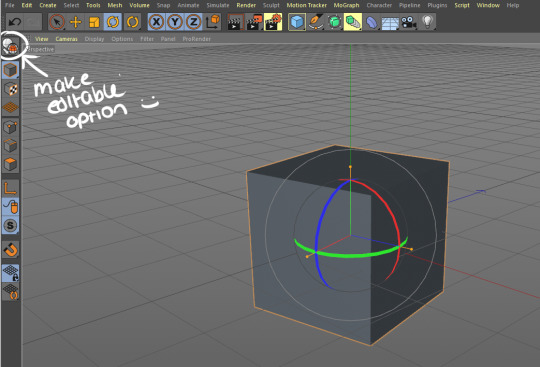
Once selecting this, you can further edit the object by selecting a vertex, an edge or a face of the shape - as well as using the rotation, size and movement tools.
The vertex:
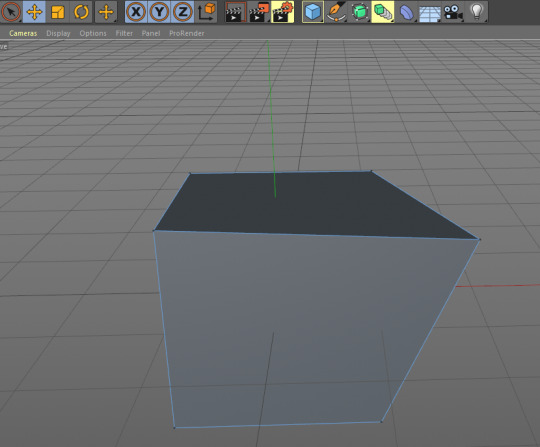
using the move tool and selecting a vertex of the cube, you can drag the corner which will stretch the rest of the shape accordingly. You can also select multiple vertices by holding shift and clicking on them, allowing you to move the position of all of them at once.
The edge tool allows you to do the same thing to single or multiple edges. The face tool allows you to move or rotate an entire face at once.
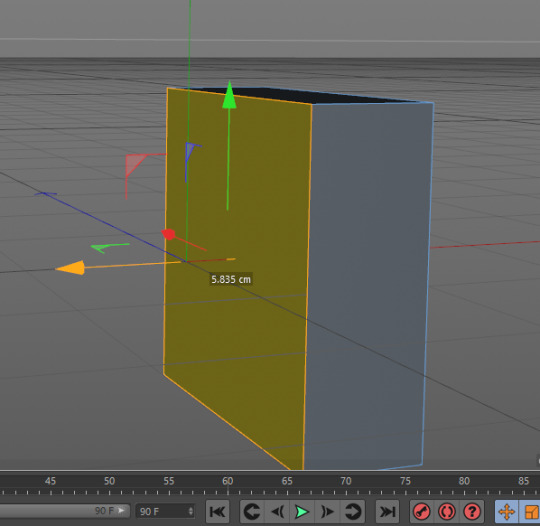
using the move tool to decrease the width of the cube.

To make this chair, I used 3 cubes. I made them all editable to begin with. The base of the chair was made by using the move tool on the top face to make the height shorter. After, this, it was moved upwards by selecting the entire shape with the move tool.
The chair leg was created by decreasing the width and height of both vertical faces, then positioning in the corner of the base. It was then copied and pasted 3 more times and moved. The back of the chair was created the same way as the base.
Creating a chair using only one cube:
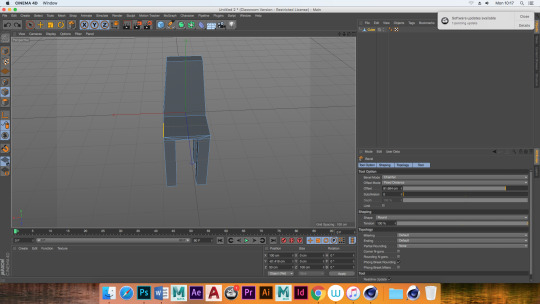
First, I made the cube editable then created the base by decreasing the cube’s height. Next, I selected the bottom face of the cube, right clicked and selected subdivide.
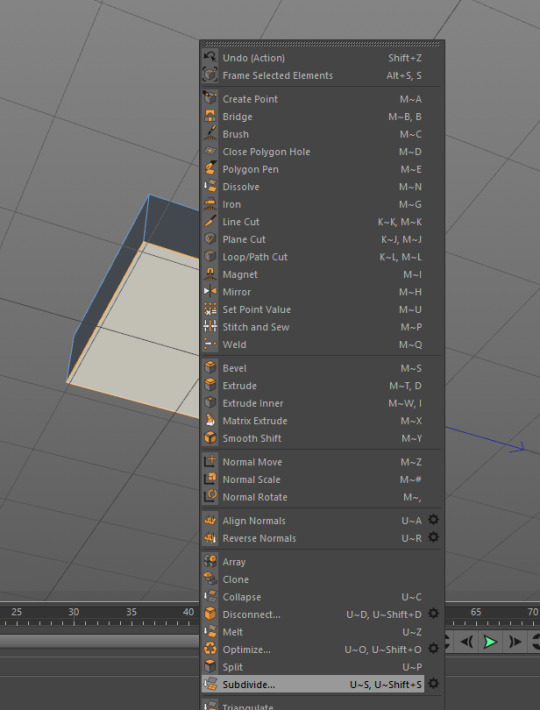
This splits the bottom face into 4 more faces that can be individually edited. Now I selected one of the new faces and subdivided again. This created 16 faces on the bottom of the cube. To make the legs, I just selected all the 4 corner faces (while holding shift) and dragged them out. However, in order to make it work properly, you have to hold down the ctrl key.
the back of the chair was made the same way.
Making a more complicated chair :
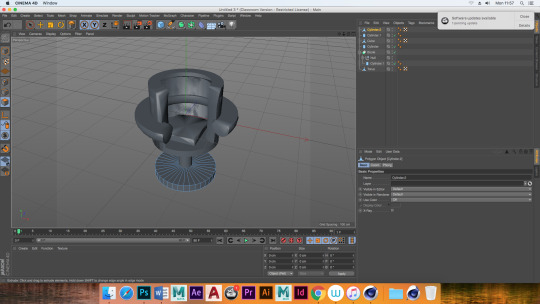
To make this chair, I started off with an Oil Tank instead of a cube.

I used the loop selection tool (edit>loop selection) to select the parts of the oil tank I didn’t want to use. I then used backspace to delete them.
Next, I used the ring selection to remove the upper portion of the top face. After, this, I gave the main part of the chair thickness by going to simulate>cloth>cloth surface. To make this work, I dragged the oil tank inside of the cloth layer, then adjusted the thickness to -10cm

I did the same thing to the disk at the base of the chair.
The arms of the chair were created using the Torus shape. I removed the front portion of the shape using the ring selection tool. After this, I added the front of the arms by right clicking and choosing the ‘close polygon hole’ option then selecting the circular opening. After this, I used live selection to select the top p portion of the torus and delete it. Before closing the polygon hole,I had to cut the two circles on the end (using the knife) so that they were the same shape as the rest of the arm.
I used a small cylinder for the bottom and a disk as the base. I also used a sibdivided cube that was bevelled as a pillow/decoration.
This process was largely trial and error and was a lot easier building it a second time after I looked up tutorials and experimented with more of the tools available.

Making a terrain:
To make a terrain in C4D I started off with a Landscape (as opposed to a cube) then changed the width and height segments to 400 (in the bottom right hand corner). After this, I made the landscape editable and used the brush tool.
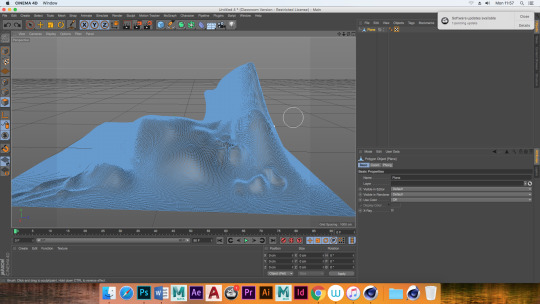

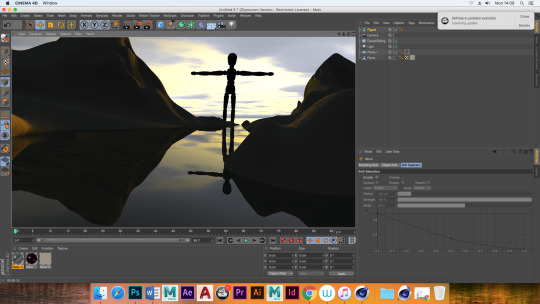

Captain’s chairs - Star Trek

This captain’s chair is composed of straight edges and blocky shapes which looks like it’d be relatively easy to make in a 3D modelling program. I also really like the simple design and contrasting colours that were used. However, I’d like to make something more complicated and smooth than this model for my own project.
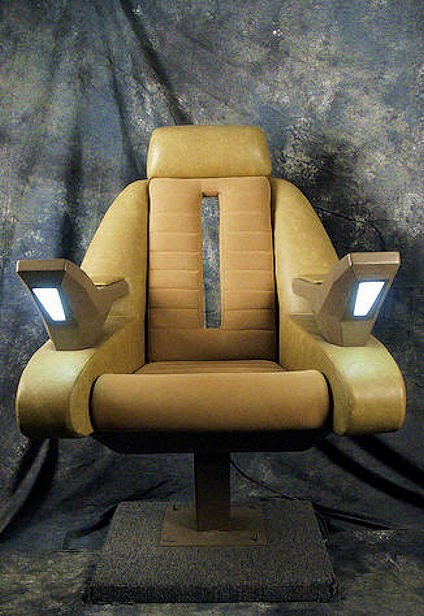
This chair is very curved and in my opinion looks a lot more futuristic than the previous chair. It has a much more interesting layout and also includes lights, as well as a smaller base piece. I like the base and the arms but not the general shapes of the chair as I think it looks a little old fashioned.

I really like the shape of this chair due to the way the pieced are connected - the arms are one curved piece which connects underneath the chair to support the base, which is really unique. I also like the design of the cushions, and will take inspiration from this for my own design.
0 notes
Text
Your Guide To Staying Alive While Flying Low
Flying low gives you a view of the world you can't get from 5,000 feet AGL. But before you do it, make sure you know the rules of the air and carefully study the terrain and obstacles you'll encounter along the way.
“If you’re going to fly low,” said my first flight instructor, “you had better know how to do it right.” We then cranked up the old Aeronca Champion and went out for a low-level dual excursion around the countryside. As I found out during his pre-planned route, things looked different from a traffic-pattern perspective. We didn’t break any minimum-altitude rules, we just didn’t climb up to the usual 2,000-feet AGL cruising level. For his training objective, flying at 800 feet or so was low enough.
Why would you ever fly so low? As he explained, it might be necessary to stay that low just to remain in VFR conditions when the weather suddenly collapses and you need to turn around and get back home. And we occasionally participated in Civil Air Patrol search missions, which had to be conducted at low level. Amateur attempts at aerial photography require some expertise in flight at low altitude. Plus, once in a while you just want to go sightseeing instead of riding an electronic course line in the upper airspace.
I will note here that all of these kinds of missions carry with them considerable additional risk. How much is hard to say, but it’s a lot. These kinds of flights aren’t common, and yet the accident record shows an inordinate number of accidents blamed on low-level manuevering, or “buzzing,” as we often refer to it. Accidents caused by mistakes when maneuvering at low level are usually fatal ones, and the accidents have a common theme: The pilots who were flying low had little experience with low-level flying, they were doing so on the spur of the moment, and they had, hence, not formulated a plan.
There are also regulatory and neighborly considerations. As my grizzled CFI pointed out, there are some operational differences to be observed when flying at low level. We need to be considerate of other people, such as those living under our flight path. To reduce our noise footprint, we should pull the power back to a low-cruise setting and stay away from built-up housing areas. Even though we’re not flying over a town, there can be clusters of developments along highways, and there are isolated schoolyards and even airports that should be avoided. Open countryside is our objective, although we may encounter a farmhouse along the way.
From a legal standpoint, you can fly as low as 500 feet above open countryside or 1,000 feet above congested areas and open-air crowds.
What’s Legal?
What are the regulations concerning minimum altitudes to be observed? The “minimum safe altitude” rules have been essentially unchanged since the 1940s, which means they are not always logically applicable in this day and age. But from a legal standpoint, you can fly as low as 500 feet above open countryside or 1,000 feet above congested areas and open-air assemblies of persons, as measured from the top of any obstruction within 2,000 feet of the aircraft. The 500-foot rule also applies to lateral distance from any structure or person when flying below 500 feet AGL over water or unpopulated areas. Even when I learned to fly, these were considered DUMB rules. Flying at 500 feet above the ground should be considered a last resort, reserved for extracting oneself from an emergency bad-weather situation. One should avoid using the ancient rules written for J-3 Cubs when operating faster, less-maneuverable modern airplanes.
What hangar lawyers often fail to recognize is the beginning paragraph of FAR 91.119, which makes the pilot responsible for maintaining an altitude allowing for the safe execution of an emergency landing “without undue hazard to persons or property on the surface” after an engine failure. Regardless of the verbiage that follows it, the FAA expects pilots to add enough extra altitude to carry out the duties inherent in this sub-paragraph (a). If found to be negligent in this respect, you may be subject to a violation.
Bear in mind that the ADS-B Out data stream is a game changer when it comes to proving culpability. No longer is it possible to contest the opinion of eyewitnesses or the momentary hit of a transponder reply. ADS-B knows all and tells all, right down to ground level.
Therefore, it behooves us to do our low-altitude flying with regard to today’s exigencies. Flying low is still a valid option, but a growing population sprawl and more tender sensibilities require us to exercise due care.
If you feel the urge to take a photo or two, don’t do it at low altitude, where flying the plane deserves your full attention.
The Way To Do It
As we leveled off at a few hundred feet, my CFI pointed out the diminished perspective afforded by low-level flight. Landmarks came and went quickly—now you see it, now you don’t. One needed to keep track of one’s location on the chart and, more importantly, what was ahead on the route, because there wasn’t much visual warning of its approach. Practically speaking, we would have fewer forced landing options if our engine quit down on the deck, another reason to keep our eyes outside, constantly watching for possible safe havens or avoiding unlandable areas.
To make the task of low-level pilotage easier, a common solution is to pick a road, waterway or rail line going in the right direction and just follow it. That makes it simple to anticipate the presence of the next town up the road, bearing in mind that twists and bends in the track will frequently alter your compass direction. And when you reach a fork in the road, you have to take it, as Yogi Berra said, so make sure you go the right way.
The temptation today, of course, is to just tap a destination into the GPS and follow the magenta line, an unerringly straight path across hill and dale. While sufficient for maintaining orientation, the pink pathway can lead you into places you don’t want to traverse. Special airspaces abound, and you’ll want to give congested areas and airports a wide berth. While I may create a GPS route when flying at low-level, I’ll swing off it as necessary, taking comfort in knowing that it’s there on the screen if I get disoriented.
A much more heightened awareness of the world outside is necessary when flying low. Don’t spend more than a few seconds at a time on inside-the-cockpit tasks. A close watch has to be kept on the landscape speeding toward you, which is filled with hazards. Remember the old humorous caution about avoiding flight in the “edges of the air,” reminding us to always stay in the “middle of the air.” The edges of the air, you see, are filled with tall trees, towers, mountain ridges, buildings and powerlines. All joking aside, never forget that conducting low flight is assuming a greater risk of encountering obstructions. To manage this risk, keep your eyes outside nearly 100 percent of the time. If you have something important to do on your instrument panel, climb up to a safer altitude while taking care of it.
Flying low means staying away from unwelcoming localities. Airports, even little-used ones, should not be overflown at traffic pattern level. Take up a diversion heading that will avoid them by a couple of miles, and make a traffic advisory call to alert local planes of your intentions. Otherwise, an inbound aircraft might think you’re approaching to land and will follow you off into the boondocks before figuring out that you’re only passing through. Remember, plan ahead for airport encounters; you’re not going to see the runways and hangars from a distance when you’re down on the deck.
Consider that you have limited communication capability when you’re flying below the horizon. VHF frequencies are essentially good for line-of-sight reception, so if you need to talk with someone at any distance, you’ll have to climb back up to a more reasonable altitude. Radar contact will also be lost most of the time; even if you see the transponder’s reply light flickering, you’re not really being painted when out in the low boondocks.
Knowing how to manage the risks and challenges of low-level flight is a useful tool for your bag of flying skills, but it’s one that can’t be taken lightly.
You’re Not Alone Down There
The fatal accident involving two employees of Icon Aircraft in 2017 should serve as a wakeup call for the risks of flying low. The pilot, a high-time test pilot with tons of hours and a strong knowledge of the terrain, chose the wrong canyon to fly into at low altitude. The one selected had no outlet, and by the time he realized it, there was no escape. Flying low carries risk, and flying around high terrain carries even greater risk, far greater.
It’s not just terrain. Tall towers are an ever-present hazard when flying low, and not all of them are charted; new ones crop up all the time. GPS alerting may not help much because you’re already operating in a continuous terrain-caution condition. The solution is to stay high enough to avoid all but the most unlikely super-tall obstructions by planning in advance. Watch for the large minimum-clearance altitudes on the sectional chart, which change with every lat-long grid, and when you see that number increase, take action. The larger obstruction symbol on the chart is only used when the tower pokes above 999 feet AGL; a 950-foot tower gets the smaller symbol, but it’ll kill you just as dead if you hit it.
In addition, avoid flying in the bottom of narrow valleys and canyons; stay at ridge level or above. There are often powerlines strung across the valleys that sag quite low between the supporting structures, so make sure you have clearance above the poles and towers.
Remember to be considerate of the effect of the noise you’re making. You may be insulated by the speed of your passage and your noise-canceling ANR headsets, but people under your flight path are not. Rattling windows as you pass by is not a friendly gesture. If you have a constant-speed propeller, dial it back to a low-rpm cruise setting. Most of the annoying noise impact from a light airplane comes from the propeller tips stirring up the air at transonic speed. The fun of flying low is enhanced by reducing airspeed for sightseeing. High-performance, heavy-horsepower airplanes are not suited for such cruising; flying at 3 miles per minute turns the landscape into a blur, so you’ll probably want to stay above 3,000 feet AGL if flying such an airplane.
And should you feel the urge to take a photo or two, don’t do it at low altitude, where flying the plane deserves your full attention.
Knowing how to manage the risks and challenges of low-level flight is a useful tool for your bag of flying skills, but it’s one that can’t be taken lightly.
The post Your Guide To Staying Alive While Flying Low appeared first on Plane & Pilot Magazine.
from Plane & Pilot Magazine http://bit.ly/2Kljsrx
0 notes
Text
The creator of Dilbert explains Trump's persuasion style and reminds us why people stopped caring about facts
Reuters/Carlos Barria
In this excerpt from "Win Bigly," Dilbert creator Scott Adams says both he and Trump use the same method of persuasion.
The method involves making claims that contain exaggerations or factual errors.
Adams credits the method with raising his own profile ahead of the 2016 US presidential election — and with Trump's election win.
Adams says he doesn't prefer to ignore facts.
It's just that a "Master Persuader" can do it and still come out on top.
In August 13, 2015, I predicted in my blog that Donald Trump had a 98 percent chance of winning the presidency based on his persuasion skills.
A week earlier, the most respected political forecaster in the United States—Nate Silver—had put Trump’s odds of winning the Republican nomination at 2 percent in his FiveThirtyEight.com blog.
In those early days of the election, the overwhelming majority of pundits in the business regarded Trump as a novelty and a sideshow.
Persuasion is all about the tools and techniques of changing people’s minds, with or without facts and reason. When I started writing favorable blog posts about Trump’s persuasion talents, it felt like going to war alone.
In California, where I live, it seemed as if most Trump supporters were in hiding because of the social and career risks of publicly supporting him. I wasn’t counting on anyone’s having my back in this fight.
Courtesy of Scott AdamsLuckily, I was wrong. Trump’s Twitter followers adopted me immediately and had my back every step of the way. When the critics came after me on Twitter and elsewhere, Trump supporters flooded in to back me.
I didn’t ask them to do it. They just did. One of my motivations for writing this book is that so many people who supported me on Twitter specifically asked me to write it. This book is a favor returned.
By the way, reciprocity is a big thing in persuasion. When you do someone a favor, it triggers an automatic reciprocity reflex in the recipient. Humans are hardwired to reciprocate kindness.
Sales professionals use this persuasion method all the time. If a salesperson buys you lunch or fixes a problem for you, you’re being persuaded.
You might think you can resist persuasion techniques just by recognizing them in action. But knowing the technique won’t protect you as much as you might think. See Persuasion Tip 3.
So why did I say Trump had exactly a 98 percent chance of winning when I couldn’t possibly know the odds?
Why did I say Trump had exactly a 98 percent chance of winning when I couldn’t possibly know the odds?
If that’s a persuasion technique. You saw Trump use the intentional wrongness persuasion play over and over, and almost always to good effect.
The method goes like this:
1. Make a claim that is directionally accurate but has a big exaggeration or factual error in it.
2. Wait for people to notice the exaggeration or error and spend endless hours talking about how wrong it is.
3. When you dedicate focus and energy to an idea, you remember it. And the things that have the most mental impact on you will irrationally seem as though they are high in priority, even if they are not. That’s persuasion.
I picked 98 percent because Nate Silver was saying 2 percent. I did that for branding and persuasion purposes.
If I had boringly predicted that Trump would win the election, without any odds attached to it, the public would have easily shrugged it off as another minor celebrity’s irrelevant opinion.
But if I make you pause to argue with me in your mind about the accuracy of the 98 percent estimate, it deepens my persuasion on the main point—that Trump has a surprisingly high likelihood of winning.
I picked 98 percent as my Trump prediction because Nate Silver of FiveThirtyEight.com was saying 2 percent. I did that for branding and persuasion purposes.
It is easier to remember my prediction both because of the way it fits with Silver’s prediction and for its audacity, which people perceived as “wrongness.” The prediction was designed to attract attention, and it did.
It was also designed to pair my name with Nate Silver’s name to raise my profile by association. That worked too. Social media folks mentioned me in the same sentence with Silver countless times during the election, exactly as I had hoped. And every mention raised my importance as a political observer because I was being compared with someone already important in that field.
Keep in mind that at this point in our story I was playing the wrong sport. I was a cartoonist writing about politics and persuasion.
I needed whatever credibility I could get to build an audience for my Trump blogging. Using a little bit of wrongness (my precise 98 percent prediction), I managed to attract more attention than I would have otherwise.
And that conferred on me some credibility by association. As long as I was literally in the same sentence with Nate Silver, I would gain some credibility by proximity alone.
Thomson ReutersTrump used the intentional wrongness persuasion play off then, and it seemed to work every time, at least in terms of attracting attention where he wanted it. It even works when you know he’s doing it. If you’re talking about whatever topic he wants you to focus on, he has your mind right where he wants it, even if you are criticizing him for his errors while you are there.
For example, take Trump’s campaign promise that he would build a “wall” on the border of Mexico.
Common sense tells you that solid walls are not the best solution for all types of terrain. In many locations, the most cost-effective solutions might include wire fences, or digital monitoring of various types, or something else.
If Trump had wanted to be accurate, he would have mentioned all of those solutions every time he talked about border security.
He did make some casual admissions that the border would be secured in different ways in different places. But most of the time he ignored those details, and wisely so.
By continuing to call it a “wall” without details, he caused the public and the media to view that as an error.
So they argued about it. They fact-checked it. They put together cost estimates.
They criticized Trump for not understanding that it couldn’t be a “wall” the entire way.
How stupid can he be?????
And when they were done criticizing Trump for the “error” of saying he would build one big solid “wall,” the critics had convinced themselves that border security was a higher priority than they had thought coming into the conversation.
Reuters/Mike BlakeThe ideas that you think about the most are the ones that automatically and irrationally rise in your mental list of priorities. And Trump made us think about the wall a lot. He did that because he knew voters would see him as the strongest voice on the topic.
It also sucked up media energy that might have focused on political topics he didn’t understand at the same depth as his competitors. Master Persuaders move your energy to the topics that help them, independent of facts and reason.
I’ve said Trump is the best persuader I have ever seen in action. The wall is a perfect example. Consider how much discipline it took for him to avoid continually clarifying that his “wall” was really a patchwork of solutions that depend on the terrain.
In order to pull off this type of weapons grade persuasion, he had to be willing to endure brutal criticism about how dumb he was to think he could secure the border with a solid wall.
To make those criticisms go away, all Trump needed to do was clarify that the “wall” was actually a variety of different border solutions, depending on cost and terrain, every time he mentioned it. Easy as pie.
But the Master Persuader didn’t want the critics to be silenced. He wanted them to make border control the biggest issue in the campaign just by talking nonstop about how Trump’s “wall” was impractical.
As long as people were talking about the wall, Trump was the most important person in the conversation. The Master Persuader moves energy and attention to where it helps him most.
And what about the facts and details? Not so important. Those can get worked out later.
I don’t believe Trump purposely injects errors into his work except in the form of oversimplification and hyperbole, as in the wall example. That stuff is intentional for sure. But for the smaller “errors” it is more that he doesn’t bother to correct himself.
Tom Pennington/Getty ImagesI use a similar technique with my blog when someone points out a typo.
Sometimes I leave the typo because it makes you pause and reread the sentence a few times to figure out what the typo was supposed to mean. The “mistake” attracts your energy to my writing, and that’s what a writer wants. I want your focus.
Some mistakes are just ordinary mistakes. But when you see a consistent stream of “mistakes” from a Master Persuader, be open to the possibility that some of those mistakes are about controlling your focus and energy.
When you first saw the title of this book, did you think to yourself that Trump doesn’t say “bigly,” he says “big league”?
If you noticed my title “error,” it probably helped you remember the book. And now whenever you hear the words “bigly” or “big league” in some other context, it will make you think of this book.
The things you think about the most, and remember best, seem more important to you than other things. That’s the persuasion I engineered into the title.
During the presidential campaign, it seemed that candidate Trump was making one factual error aIf ther another. Social media and the mainstream media were in a feeding frenzy. If they called him a liar, a con man, and just plain stupid. Some went so far as to question his sanity.
Even more puzzling, Trump often stuck to his claims after the media thoroughly debunked them in front of the world. He still didn’t budge. It was mind-boggling. No one was quite sure if the problem was his honesty, his lack of homework, or some sort of brain problem. But one thing we all knew for sure was that it was hard to ignore.
If you have ever tried to talk someone out of their political beliefs by providing facts, you know it doesn’t work. That’s because people think they have their own facts. Better facts. And if they know they don’t have better facts, they change the subject. People are not easily switched from one political opinion to another. And facts are weak persuasion.
So Trump ignores facts whenever they are inconvenient. I know you don’t want to think this works in terms of persuasion. But it does.
Trump ignores facts whenever they are inconvenient. I know you don’t want to think this works in terms of persuasion. But it does.
And I know you want to believe that having a president who ignores facts makes the world a worse place, in a number of vague ways that you can’t quite articulate. But Trump tends to be directionally accurate on the important stuff, and the little stuff never seems to matter.
I want to be clear that I’m not expressing a preference for ignoring facts.
I’m simply saying that a Master Persuader can do it and still come out ahead, no matter how many times the media points out the errors.
The average consumer of political news can hold only a handful of issues in his head. Any of the lesser topics get flushed out of memory. So Trump can invent any reality he wants for the less important topics. All you will remember is that he provided his reasons, he didn’t apologize, and his opponents called him a liar like they always do.
True story: Ten minutes ago I read a long list of Trump’s tweets that PolitiFact judged to be factually inaccurate. I can recall only a few of them. They all blended together in my mind, and none made much of an impression. I had no personal or emotional connection to any of them. They were just background noise.
If Trump had apologized for any of his factual “errors,” I would remember whatever alleged wrongness triggered the apology.
If Trump had apologized for any of his factual 'errors,' I would remember whatever alleged wrongness triggered the apology.
That would stick in my mind. I assume that’s at least partly why he doesn’t do apologies. Apologizing would be a sign of weakness and invite continual demands for more apologies.
In Trump’s specific case, apologies wouldn’t have helped his campaign because there would have been too many demands for them. But in the case of normal people who are not Master Persuaders and only occasionally make public mistakes, apologies are still usually the right way to go.
If I haven’t yet persuaded you that “mistakes” can be useful in persuasion, consider a small 2012 study by researcher Daniel Oppenheimer that found students had better recall when a font was harder to read.3
Oppenheimer explains the unexpected result by noting that people slow down and concentrate harder to compensate for the hard to-read font. That extra concentration is what makes lasting memories form.
For more science on the topic of how intentional “mistakes” can aid in memory retention, I recommend the book Impossible to Ignore, by Dr. Carmen Simon.
The gist of it is that you need to surprise the brain or make it work a little extra to form memories. Our brains automatically delete our routine memories fairly quickly. Most of us don’t know what we were doing on this day a year ago. But we easily remember things that violate our expectations.
A good general rule is that people are more influenced by visual persuasion, emotion, repetition, and simplicity than they are by details and facts.
Trump inaccurately described his plans for the wall—it probably won’t be a physical wall for the entire border span—and that lowered his credibility and tainted his brand.
Courtesy of Scott Adams/Penguin Random HouseBut he makes up for it by using solid gold visual persuasion, calls to emotion, simplicity, repetition, and the “mistake” itself to make his wall idea compelling.
If you’re using super strong persuasion, you can be wrong on the facts, and even the logic of your argument, and still win.
I will pause here to tell you that while there is lots of science behind the best ways to influence people, choosing among the many ways to persuade via “surprising the brain” can be more art than science.
No two situations are alike, so knowing what methods of persuasion worked in a different context might not help you in your current situation.
Warning: Intentionally ignoring facts and logic in public is a dangerous strategy unless you are a Master Persuader with thick skin and an appetite for risk. Most of us don’t have the persuasion skills, risk profile, and moral flexibility to pull it off.
We don’t know for sure that Trump came out ahead by oversimplifying his wall idea to the point where it sounded crazy to critics and even some supporters.
But in my judgment, he probably did come out ahead. By inauguration day, we were talking about the costs and the details of the wall; the country had already accepted that the wall would probably get built, at least in part. And in the long run, presidents are judged by their success.
Love it or hate it, historians will someday probably judge Trump’s wall to be a presidential success story. Success cures most types of “mistakes.”
Scott Adams is the creator of the popular comic Dilbert. In 2015, Adams predicted that Trump had a 98% chance of winning the 2016 US presidential election. Adams based this prediction on Trump’s persuasion tactics.
NOW WATCH: Watch Paul Manafort — Trump's former campaign chairman — surrender to the FBI
from Feedburner http://ift.tt/2z9JtCO
0 notes